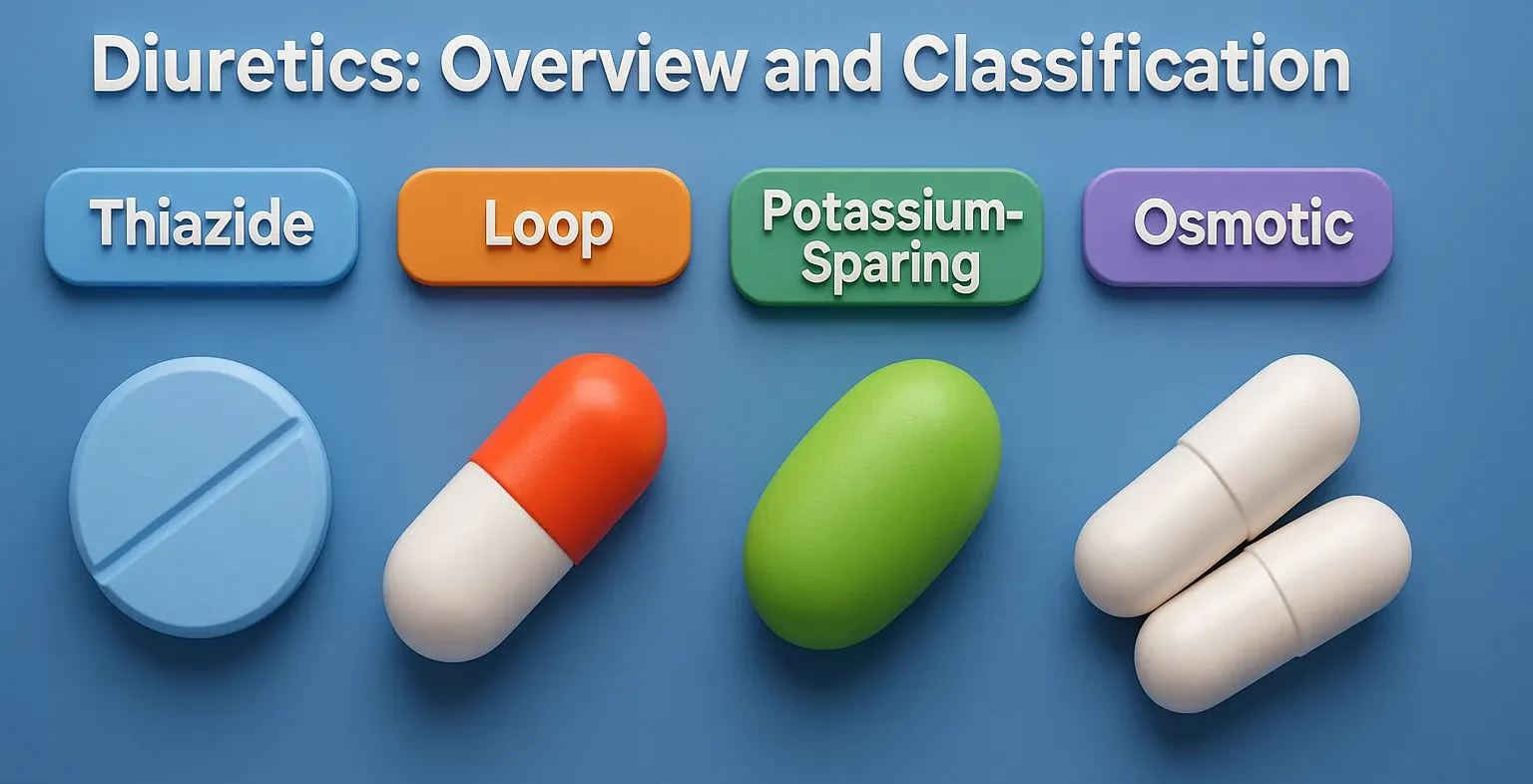- Diuretics are a class of medications that promote the excretion of water and electrolytes (such as sodium and potassium) through the kidneys.
- They are primarily used to manage conditions like hypertension (high blood pressure), heart failure, kidney disorders, and certain cases of edema (fluid retention).
- By increasing urine output, diuretics help reduce blood volume, thereby lowering blood pressure and decreasing the workload on the heart.
Classification of Diuretics
- Diuretics can be categorized based on their mechanism of action and the specific segment of the nephron (the functional unit of the kidney) they act upon.
- Below is a concise classification of diuretics along with common examples and their primary mechanisms:

1. Carbonic Anhydrase Inhibitors
-
Examples:
-
Mechanism of Action:
- Inhibit the enzyme carbonic anhydrase in the proximal tubule of the nephron.
- Reduce reabsorption of bicarbonate, leading to increased excretion of bicarbonate, sodium, potassium, and water.
-
Clinical Uses:
Advertisements
2. Thiazide Diuretics
-
-
Examples:
-
Mechanism of Action:
- Act on the distal convoluted tubule.
- Inhibit the sodium-chloride symporter, reducing sodium and chloride reabsorption.
- Increase excretion of sodium, chloride, and water, while promoting potassium retention.
-
Clinical Uses:
- Hypertension management.
- Edema associated with heart failure or nephrotic syndrome.
- Prevention of calcium-containing kidney stones.
-
3. Loop Diuretics
-
-
Examples:
-
Mechanism of Action:
- Target the ascending limb of the loop of Henle.
- Inhibit the sodium-potassium-chloride (Na⁺-K⁺-2Cl⁻) cotransporter.
- Significantly increase excretion of sodium, chloride, potassium, calcium, and magnesium.
-
Clinical Uses:
- Acute and chronic heart failure.
- Pulmonary edema.
- Hypertension.
- Acute kidney failure.
-
4. Potassium-Sparing Diuretics
-
-
Examples:
-
Mechanism of Action:
- Act on the collecting ducts and late distal tubule.
- Spironolactone: Aldosterone receptor antagonists; block sodium reabsorption and potassium excretion.
- Triamterene and Amiloride: Inhibit epithelial sodium channels (ENaC), reducing sodium reabsorption and potassium loss.
-
Clinical Uses:
- Heart failure.
- Hypertension.
- Prevention of hypokalemia in patients taking other diuretics.
- Primary hyperaldosteronism (Spironolactone).
-
5. Osmotic Diuretics
-
-
Examples:
-
Mechanism of Action:
- Remain in the lumen of the nephron and inhibit water reabsorption by increasing the osmolarity of the filtrate.
- Do not undergo significant reabsorption, thus drawing water into the urine.
-
Clinical Uses:
- Reduction of intracranial pressure in cases of cerebral edema.
- Treatment of acute kidney failure.
- Prevention of renal toxicity in certain poisoning cases.
-
Summary Table
Category |
Medications |
Primary Mechanism |
Carbonic Anhydrase Inhibitors |
Acetazolamide, Methazolamide, Dichlorphenamide | Inhibit carbonic anhydrase in proximal tubule; increase excretion of bicarbonate, sodium, potassium, water |
Thiazide Diuretics |
Chlorthiazide, Hydrochlorothiazide, Hydroflumethiazide, Cyclothiazide | Inhibit Na⁺-Cl⁻ symporter in distal convoluted tubule; increase excretion of sodium, chloride, water |
Loop Diuretics |
Furosemide, Bumetanide, Ethacrynic acid | Inhibit Na⁺-K⁺-2Cl⁻ cotransporter in ascending limb of loop of Henle; increase excretion of Na⁺, Cl⁻, K⁺, Ca²⁺, Mg²⁺ |
Potassium-Sparing Diuretics |
Spironolactone, Triamterene, Amiloride | Spironolactone: Aldosterone antagonists; Triamterene & Amiloride: ENaC inhibitors; reduce Na⁺ reabsorption and K⁺ loss |
Osmotic Diuretics |
Mannitol | Increase osmolarity of filtrate; inhibit water reabsorption |
Click Here to Watch the Best Pharma Videos
Advertisements

